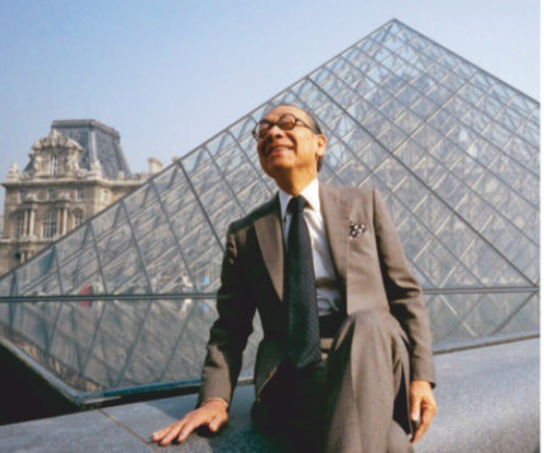In 1974 he managed to return; later he built, for the government, a hotel complex at Fragrant Hill outside Beijing. He seized on this as a chance to wean the Chinese away from their drab eastern European blocks and back to the domestic traditions they had lost. But their break with the past had been too definite; they now wanted to copy the West, and did not care for the old motifs he combined with his geometry and glass.
1974年,他回到了中國,后來他為政府建造了位于北京郊外香山的一家綜合酒店。他抓住了這個機會,讓中國人擺脫他們單調乏味的東歐街區,回歸他們已經失去的國內傳統。但是他們與過去的決裂太明確了,他們現在想要模仿西方,他不喜歡與幾何和玻璃結合在一起的舊圖案。
He did better with the Bank of China Tower for the bank his father had run, where his shaft of 70 slim, dark storeys, criss-crossed with white lines, was based on the angular growth of bamboo. Visiting shrines in the mountains once in childhood, he thought he heard the bamboo growing. Those mountains, like the gardens, led him to seek tranquillity in the buildings he designed. They sometimes seemed too exciting for that: sweeping stairways, soaring glass, razor-sharp angles,scintillating slopes.
他的中國銀行大廈的設計做得更好,因為他父親曾經營那家銀行,這個修長、底部暗黑、有著縱橫交錯的白線的70層大樓,是基于竹子的角形生長設計的。有一次,他去山里的神祠,他覺得自己聽到了竹子的生長。那些山峰就像花園一樣,使他在自己設計的建筑里尋找寧靜。它們有時似乎太令人興奮了,以至于無法做到這一點:大規模的樓梯、高聳的玻璃、鋒利的角度、閃閃發光的斜坡。

But at their heart lay those perfect forms, triangle, circle and square. Water often lay nearby, offering both transparency and reflection. A pyramid with water round it, as at the Louvre, was the very essence of serenity: harmony of structure and spirit. It might take time to make its case; architecture was a slow art. But as it moved from newness to permanence, he felt beamingly sure that Parisians would agree with him.
但在他們的中心卻有著那些完美的形狀,三角形、圓形和正方形。水通常就在附近,既透明又有倒影。像盧浮宮一樣,金字塔周圍環繞著水,那是寧靜的精髓:結構與精神的和諧。這可能需要時間來證明。建筑是一種慢藝術。但當它從新鮮走向永恒時,他非常確信巴黎人會同意他的觀點。
譯文由可可原創,僅供學習交流使用,未經許可請勿轉載。












